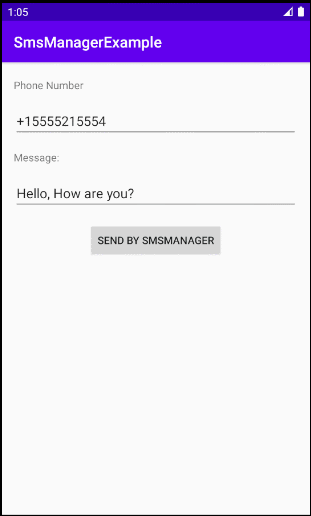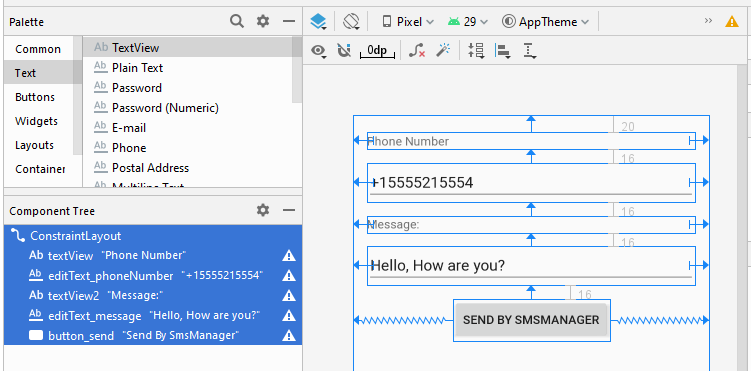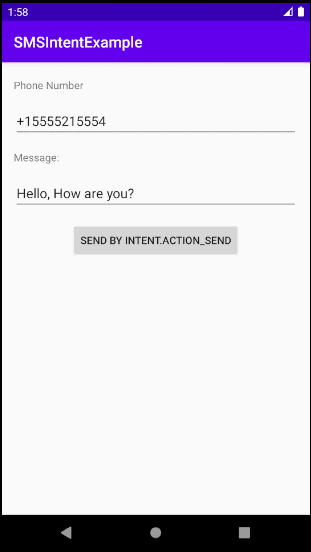Le Tutoriel de Android SMS
1. Envoyez des SMS sur Android
Dans Android, il existe essentiellement deux façons d'envoyer un SMS: en utilisant SmsManager et Intent.ACTION_SEND.
SmsManager
SmsManager vous permet d'envoyer des SMS directement depuis votre application vers n'importe quel numéro de téléphone.
Intent.ACTION_SEND
À partir de votre application, vous pouvez créer un Intent implicite (implicit Intent) envoyée au système Android pour demander au système de vous envoyer des messages. Pour ce faire, le système ouvrira la meilleure application d'envoi de SMS disponible sur le système, et il utilisera très probablement l'application Messenger.
L'application Messenger est une application d'envoi de SMS disponible sur Android que tous les utilisateurs connaissent.
Si vous testez des applications d'envoi de SMS sur Android Emulator (Émulateur d'Android), vous devez connaître son numéro de téléphone et vous pouvez tester l'application en envoyant des SMS à ce numéro de téléphone.
2. Envoyez SMS avec SmsManager
SmsManager est une classe disponible sur Android, elle vous permet d'envoyer un SMS directement à n'importe quel numéro de téléphone.
Dans cet exemple, je vais envoyer un SMS au numéro de téléphone de l'appareil en cours de test, donc dès que j'appuie sur le bouton d'envoi, je vois une notification pour recevoir un SMS. Exemple d'aperçu:

Remarque: Si l'utilisateur a autorisé l'application à envoyer des messages SMS, l'application n'aura pas besoin de demander à nouveau à l'utilisateur lors du prochain envoi de SMS, vous devrez donc parfois supprimer les autorisations (permission) accordées à l'application pour pouvoir tester l'application plus complètement.
OK, sur Android Studio, créez un projet:
- Name: SmsManagerExample
- Package name: org.o7planning.smsmanagerexample
Ajoutez le code XML suivant au fichier AndroidManifest.xml pour permettre à l'application d'envoyer des SMS. Remarque: Avec Android 6.0+ (API niveau 23+), votre application doit demander à l'utilisateur la permission d'envoyer des SMS (voir également dans l'exemple de code).
<uses-permission android:name="android.permission.SEND_SMS"/>AndroidManifest.xml
<?xml version="1.0" encoding="utf-8"?>
<manifest xmlns:android="http://schemas.android.com/apk/res/android"
package="org.o7planning.smsmanagerexample">
<uses-permission android:name="android.permission.SEND_SMS"/>
<application
android:allowBackup="true"
android:icon="@mipmap/ic_launcher"
android:label="@string/app_name"
android:roundIcon="@mipmap/ic_launcher_round"
android:supportsRtl="true"
android:theme="@style/AppTheme">
<activity android:name=".MainActivity">
<intent-filter>
<action android:name="android.intent.action.MAIN" />
<category android:name="android.intent.category.LAUNCHER" />
</intent-filter>
</activity>
</application>
</manifest>L'interface de l'application:

activity_main.xml
<?xml version="1.0" encoding="utf-8"?>
<androidx.constraintlayout.widget.ConstraintLayout
xmlns:android="http://schemas.android.com/apk/res/android"
xmlns:app="http://schemas.android.com/apk/res-auto"
xmlns:tools="http://schemas.android.com/tools"
android:layout_width="match_parent"
android:layout_height="match_parent"
tools:context=".MainActivity">
<TextView
android:id="@+id/textView"
android:layout_width="0dp"
android:layout_height="wrap_content"
android:layout_marginStart="16dp"
android:layout_marginLeft="16dp"
android:layout_marginTop="20dp"
android:layout_marginEnd="16dp"
android:layout_marginRight="16dp"
android:text="Phone Number"
app:layout_constraintEnd_toEndOf="parent"
app:layout_constraintStart_toStartOf="parent"
app:layout_constraintTop_toTopOf="parent" />
<EditText
android:id="@+id/editText_phoneNumber"
android:layout_width="0dp"
android:layout_height="wrap_content"
android:layout_marginStart="16dp"
android:layout_marginLeft="16dp"
android:layout_marginTop="16dp"
android:layout_marginEnd="16dp"
android:layout_marginRight="16dp"
android:ems="10"
android:hint="Phone Number"
android:inputType="phone"
android:text="+15555215554"
app:layout_constraintEnd_toEndOf="parent"
app:layout_constraintStart_toStartOf="parent"
app:layout_constraintTop_toBottomOf="@+id/textView" />
<TextView
android:id="@+id/textView2"
android:layout_width="0dp"
android:layout_height="wrap_content"
android:layout_marginStart="16dp"
android:layout_marginLeft="16dp"
android:layout_marginTop="16dp"
android:layout_marginEnd="16dp"
android:layout_marginRight="16dp"
android:text="Message:"
app:layout_constraintEnd_toEndOf="parent"
app:layout_constraintStart_toStartOf="parent"
app:layout_constraintTop_toBottomOf="@+id/editText_phoneNumber" />
<EditText
android:id="@+id/editText_message"
android:layout_width="0dp"
android:layout_height="wrap_content"
android:layout_marginStart="16dp"
android:layout_marginLeft="16dp"
android:layout_marginTop="16dp"
android:layout_marginEnd="16dp"
android:layout_marginRight="16dp"
android:ems="10"
android:inputType="text"
android:text="Hello, How are you?"
app:layout_constraintEnd_toEndOf="parent"
app:layout_constraintStart_toStartOf="parent"
app:layout_constraintTop_toBottomOf="@+id/textView2" />
<Button
android:id="@+id/button_send"
android:layout_width="wrap_content"
android:layout_height="wrap_content"
android:layout_marginTop="16dp"
android:text="Send By SmsManager"
app:layout_constraintEnd_toEndOf="parent"
app:layout_constraintStart_toStartOf="parent"
app:layout_constraintTop_toBottomOf="@+id/editText_message" />
</androidx.constraintlayout.widget.ConstraintLayout>MainActivity.xml
package org.o7planning.smsmanagerexample;
import androidx.appcompat.app.AppCompatActivity;
import androidx.core.app.ActivityCompat;
import android.Manifest;
import android.content.Intent;
import android.content.pm.PackageManager;
import android.os.Bundle;
import android.telephony.SmsManager;
import android.util.Log;
import android.view.View;
import android.widget.Button;
import android.widget.EditText;
import android.widget.Toast;
public class MainActivity extends AppCompatActivity {
private static final int MY_PERMISSION_REQUEST_CODE_SEND_SMS = 1;
private static final String LOG_TAG = "AndroidExample";
private EditText editTextPhoneNumber;
private EditText editTextMessage;
private Button buttonSend;
@Override
protected void onCreate(Bundle savedInstanceState) {
super.onCreate(savedInstanceState);
setContentView(R.layout.activity_main);
this.editTextPhoneNumber = (EditText) this.findViewById(R.id.editText_phoneNumber);
this.editTextMessage = (EditText) this.findViewById(R.id.editText_message);
this.buttonSend = (Button) this.findViewById(R.id.button_send);
this.buttonSend.setOnClickListener(new View.OnClickListener() {
@Override
public void onClick(View v) {
askPermissionAndSendSMS();
}
});
}
private void askPermissionAndSendSMS() {
// With Android Level >= 23, you have to ask the user
// for permission to send SMS.
if (android.os.Build.VERSION.SDK_INT >= android.os.Build.VERSION_CODES.M) { // 23
// Check if we have send SMS permission
int sendSmsPermisson = ActivityCompat.checkSelfPermission(this,
Manifest.permission.SEND_SMS);
if (sendSmsPermisson != PackageManager.PERMISSION_GRANTED) {
// If don't have permission so prompt the user.
this.requestPermissions(
new String[]{Manifest.permission.SEND_SMS},
MY_PERMISSION_REQUEST_CODE_SEND_SMS
);
return;
}
}
this.sendSMS_by_smsManager();
}
private void sendSMS_by_smsManager() {
String phoneNumber = this.editTextPhoneNumber.getText().toString();
String message = this.editTextMessage.getText().toString();
try {
// Get the default instance of the SmsManager
SmsManager smsManager = SmsManager.getDefault();
// Send Message
smsManager.sendTextMessage(phoneNumber,
null,
message,
null,
null);
Log.i( LOG_TAG,"Your sms has successfully sent!");
Toast.makeText(getApplicationContext(),"Your sms has successfully sent!",
Toast.LENGTH_LONG).show();
} catch (Exception ex) {
Log.e( LOG_TAG,"Your sms has failed...", ex);
Toast.makeText(getApplicationContext(),"Your sms has failed... " + ex.getMessage(),
Toast.LENGTH_LONG).show();
ex.printStackTrace();
}
}
// When you have the request results
@Override
public void onRequestPermissionsResult(int requestCode,
String permissions[], int[] grantResults) {
super.onRequestPermissionsResult(requestCode, permissions, grantResults);
//
switch (requestCode) {
case MY_PERMISSION_REQUEST_CODE_SEND_SMS: {
// Note: If request is cancelled, the result arrays are empty.
// Permissions granted (SEND_SMS).
if (grantResults.length > 0
&& grantResults[0] == PackageManager.PERMISSION_GRANTED) {
Log.i( LOG_TAG,"Permission granted!");
Toast.makeText(this, "Permission granted!", Toast.LENGTH_LONG).show();
this.sendSMS_by_smsManager();
}
// Cancelled or denied.
else {
Log.i( LOG_TAG,"Permission denied!");
Toast.makeText(this, "Permission denied!", Toast.LENGTH_LONG).show();
}
break;
}
}
}
// When results returned
@Override
protected void onActivityResult(int requestCode, int resultCode, Intent data) {
super.onActivityResult(requestCode, resultCode, data);
if (requestCode == MY_PERMISSION_REQUEST_CODE_SEND_SMS) {
if (resultCode == RESULT_OK) {
// Do something with data (Result returned).
Toast.makeText(this, "Action OK", Toast.LENGTH_LONG).show();
} else if (resultCode == RESULT_CANCELED) {
Toast.makeText(this, "Action canceled", Toast.LENGTH_LONG).show();
} else {
Toast.makeText(this, "Action Failed", Toast.LENGTH_LONG).show();
}
}
}
}3. Envoyez des SMS avec intention.ACTION_SEND
À partir de votre application, vous pouvez créer un Intent implicite (implicit Intent) envoyée au système Android pour demander au système de vous envoyer des messages. Pour ce faire, le système ouvrira la meilleure application d'envoi de SMS disponible sur le système, et il utilisera très probablement l'application Messenger.
L'application Messenger est une application d'envoi de SMS disponible sur Android que tous les utilisateurs connaissent.
Exemple d'aperçu:

Sur Android Studio, créez un projet:
- Name: SMSIntentExample
- Package name: org.o7planning.smsintentexample
Ajoutez le code XML suivant au fichier AndroidManifest.xml pour permettre à l'application d'envoyer des SMS.
<uses-permission android:name="android.permission.SEND_SMS"/>AndroidManifest.xml
<?xml version="1.0" encoding="utf-8"?>
<manifest xmlns:android="http://schemas.android.com/apk/res/android"
package="org.o7planning.smsintentexample">
<uses-permission android:name="android.permission.SEND_SMS"/>
<application
android:allowBackup="true"
android:icon="@mipmap/ic_launcher"
android:label="@string/app_name"
android:roundIcon="@mipmap/ic_launcher_round"
android:supportsRtl="true"
android:theme="@style/AppTheme">
<activity android:name=".MainActivity">
<intent-filter>
<action android:name="android.intent.action.MAIN" />
<category android:name="android.intent.category.LAUNCHER" />
</intent-filter>
</activity>
</application>
</manifest>L'interface de l'exemple d'application:

activity_main.xml
<?xml version="1.0" encoding="utf-8"?>
<androidx.constraintlayout.widget.ConstraintLayout
xmlns:android="http://schemas.android.com/apk/res/android"
xmlns:app="http://schemas.android.com/apk/res-auto"
xmlns:tools="http://schemas.android.com/tools"
android:layout_width="match_parent"
android:layout_height="match_parent"
tools:context=".MainActivity">
<TextView
android:id="@+id/textView"
android:layout_width="0dp"
android:layout_height="wrap_content"
android:layout_marginStart="16dp"
android:layout_marginLeft="16dp"
android:layout_marginTop="20dp"
android:layout_marginEnd="16dp"
android:layout_marginRight="16dp"
android:text="Phone Number"
app:layout_constraintEnd_toEndOf="parent"
app:layout_constraintStart_toStartOf="parent"
app:layout_constraintTop_toTopOf="parent" />
<EditText
android:id="@+id/editText_phoneNumber"
android:layout_width="0dp"
android:layout_height="wrap_content"
android:layout_marginStart="16dp"
android:layout_marginLeft="16dp"
android:layout_marginTop="16dp"
android:layout_marginEnd="16dp"
android:layout_marginRight="16dp"
android:ems="10"
android:hint="Phone Number"
android:inputType="phone"
android:text="+15555215554"
app:layout_constraintEnd_toEndOf="parent"
app:layout_constraintStart_toStartOf="parent"
app:layout_constraintTop_toBottomOf="@+id/textView" />
<TextView
android:id="@+id/textView2"
android:layout_width="0dp"
android:layout_height="wrap_content"
android:layout_marginStart="16dp"
android:layout_marginLeft="16dp"
android:layout_marginTop="16dp"
android:layout_marginEnd="16dp"
android:layout_marginRight="16dp"
android:text="Message:"
app:layout_constraintEnd_toEndOf="parent"
app:layout_constraintStart_toStartOf="parent"
app:layout_constraintTop_toBottomOf="@+id/editText_phoneNumber" />
<EditText
android:id="@+id/editText_message"
android:layout_width="0dp"
android:layout_height="wrap_content"
android:layout_marginStart="16dp"
android:layout_marginLeft="16dp"
android:layout_marginTop="16dp"
android:layout_marginEnd="16dp"
android:layout_marginRight="16dp"
android:ems="10"
android:inputType="text"
android:text="Hello, How are you?"
app:layout_constraintEnd_toEndOf="parent"
app:layout_constraintStart_toStartOf="parent"
app:layout_constraintTop_toBottomOf="@+id/textView2" />
<Button
android:id="@+id/button_send"
android:layout_width="wrap_content"
android:layout_height="wrap_content"
android:layout_marginTop="16dp"
android:text="Send By Intent.ACTION_SEND"
app:layout_constraintEnd_toEndOf="parent"
app:layout_constraintStart_toStartOf="parent"
app:layout_constraintTop_toBottomOf="@+id/editText_message" />
</androidx.constraintlayout.widget.ConstraintLayout>MainActivity.java
package org.o7planning.smsintentexample;
import androidx.appcompat.app.AppCompatActivity;
import android.content.Intent;
import android.net.Uri;
import android.os.Bundle;
import android.util.Log;
import android.view.View;
import android.widget.Button;
import android.widget.EditText;
import android.widget.Toast;
public class MainActivity extends AppCompatActivity {
private static final String LOG_TAG = "AndroidExample";
private EditText editTextPhoneNumber;
private EditText editTextMessage;
private Button buttonSend;
@Override
protected void onCreate(Bundle savedInstanceState) {
super.onCreate(savedInstanceState);
setContentView(R.layout.activity_main);
this.editTextPhoneNumber = (EditText) this.findViewById(R.id.editText_phoneNumber);
this.editTextMessage = (EditText) this.findViewById(R.id.editText_message);
this.buttonSend = (Button) this.findViewById(R.id.button_send);
this.buttonSend.setOnClickListener(new View.OnClickListener() {
@Override
public void onClick(View v) {
sendSMS_by_Intent_ACTION_SEND();
}
});
}
private void sendSMS_by_Intent_ACTION_SEND() {
String phoneNumber = this.editTextPhoneNumber.getText().toString();
String message = this.editTextMessage.getText().toString();
// Add the phone number in the data
Uri uri = Uri.parse("smsto:" + phoneNumber);
Intent smsIntent = new Intent(Intent.ACTION_SENDTO, uri);
// Add the message at the sms_body extra field
smsIntent.putExtra("sms_body", message);
try {
startActivity(smsIntent);
} catch (Exception ex) {
Log.e(LOG_TAG, "Your sms has failed... " + ex.getMessage(), ex);
Toast.makeText(MainActivity.this, "Your sms has failed... " + ex.getMessage(),
Toast.LENGTH_LONG).show();
ex.printStackTrace();
}
}
}Tutoriels de programmation Android
- Configurer Android Emulator en Android Studio
- Le Tutoriel de Android ToggleButton
- Créer un File Finder Dialog simple dans Android
- Le Tutoriel de Android TimePickerDialog
- Le Tutoriel de Android DatePickerDialog
- De quoi avez-vous besoin pour démarrer avec Android?
- Installer Android Studio sur Windows
- Installer Intel® HAXM pour Android Studio
- Le Tutoriel de Android AsyncTask
- Le Tutoriel de Android AsyncTaskLoader
- Tutoriel Android pour débutant - Exemples de base
- Comment connaître le numéro de téléphone d'Android Emulator et le changer?
- Le Tutoriel de Android TextInputLayout
- Le Tutoriel de Android CardView
- Le Tutoriel de Android ViewPager2
- Obtenir un numéro de téléphone dans Android à l'aide de TelephonyManager
- Le Tutoriel de Android Phone Call
- Le Tutoriel de Android Wifi Scanning
- Le Tutoriel de programmation de jeux Android 2D pour débutant
- Le Tutoriel de Android DialogFragment
- Le Tutoriel de Android CharacterPickerDialog
- Le Tutoriel Android pour débutant - Hello Android
- Utiliser Android Device File Explorer
- Activer USB Debugging sur un appareil Android
- Le Tutoriel de Android UI Layouts
- Le Tutoriel de Android SMS
- Le Tutoriel de Android et SQLite Database
- Le Tutoriel de Google Maps Android API
- Le Tutoriel de texte pour parler dans Android
- Le Tutoriel de Android Space
- Le Tutoriel de Android Toast
- Créer un Android Toast personnalisé
- Le Tutoriel de Android SnackBar
- Le Tutoriel de Android TextView
- Le Tutoriel de Android TextClock
- Le Tutoriel de Android EditText
- Le Tutoriel de Android TextWatcher
- Formater le numéro de carte de crédit avec Android TextWatcher
- Le Tutoriel de Android Clipboard
- Créer un File Chooser simple dans Android
- Le Tutoriel de Android AutoCompleteTextView et MultiAutoCompleteTextView
- Le Tutoriel de Android ImageView
- Le Tutoriel de Android ImageSwitcher
- Le Tutoriel de Android ScrollView et HorizontalScrollView
- Le Tutoriel de Android WebView
- Le Tutoriel de Android SeekBar
- Le Tutoriel de Android Dialog
- Le Tutoriel de Android AlertDialog
- Tutoriel Android RatingBar
- Le Tutoriel de Android ProgressBar
- Le Tutoriel de Android Spinner
- Le Tutoriel de Android Button
- Le Tutoriel de Android Switch
- Le Tutoriel de Android ImageButton
- Le Tutoriel de Android FloatingActionButton
- Le Tutoriel de Android CheckBox
- Le Tutoriel de Android RadioGroup et RadioButton
- Le Tutoriel de Android Chip et ChipGroup
- Utilisation des Image assets et des Icon assets d'Android Studio
- Configuration de la Carte SD pour Android Emulator
- Exemple ChipGroup et Chip Entry
- Comment ajouter des bibliothèques externes à Android Project dans Android Studio?
- Comment désactiver les autorisations déjà accordées à l'application Android?
- Comment supprimer des applications de Android Emulator?
- Le Tutoriel de Android LinearLayout
- Le Tutoriel de Android TableLayout
- Le Tutoriel de Android FrameLayout
- Le Tutoriel de Android QuickContactBadge
- Le Tutoriel de Android StackView
- Le Tutoriel de Android Camera
- Le Tutoriel de Android MediaPlayer
- Le Tutoriel de Android VideoView
- Jouer des effets sonores dans Android avec SoundPool
- Le Tutoriel de Android Networking
- Analyser JSON dans Android
- Le Tutoriel de Android SharedPreferences
- Le Tutorial de stockage interne Android (Internal Storage)
- Le Tutoriel de Android External Storage
- Le Tutoriel de Android Intents
- Exemple d'une Android Intent explicite, appelant une autre Intent
- Exemple de Android Intent implicite, ouvrez une URL, envoyez un email
- Le Tutoriel de Android Service
- Le Tutoriel Android Notifications
- Le Tutoriel de Android DatePicker
- Le Tutoriel de Android TimePicker
- Le Tutoriel de Android Chronometer
- Le Tutoriel de Android OptionMenu
- Le Tutoriel de Android ContextMenu
- Le Tutoriel de Android PopupMenu
- Le Tutoriel de Android Fragment
- Le Tutoriel de Android ListView
- Android ListView avec Checkbox en utilisant ArrayAdapter
- Le Tutoriel de Android GridView
Show More